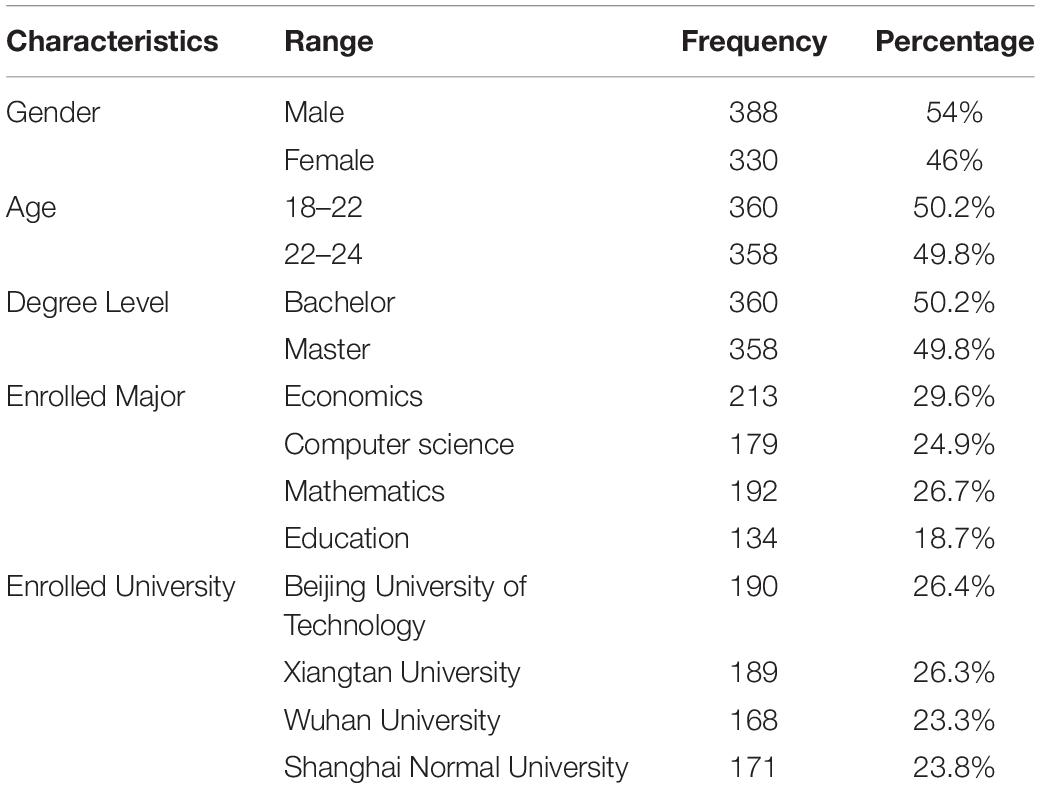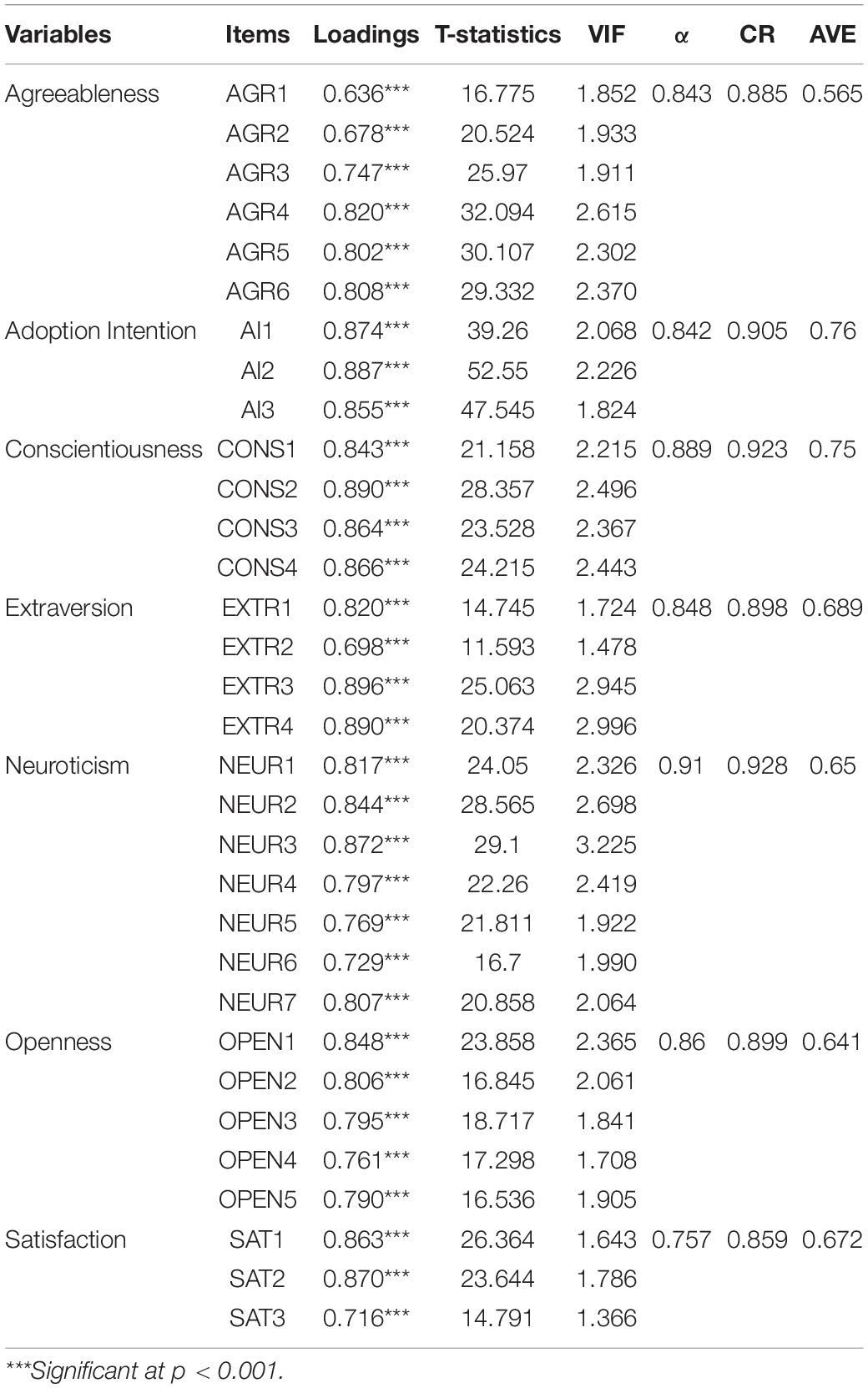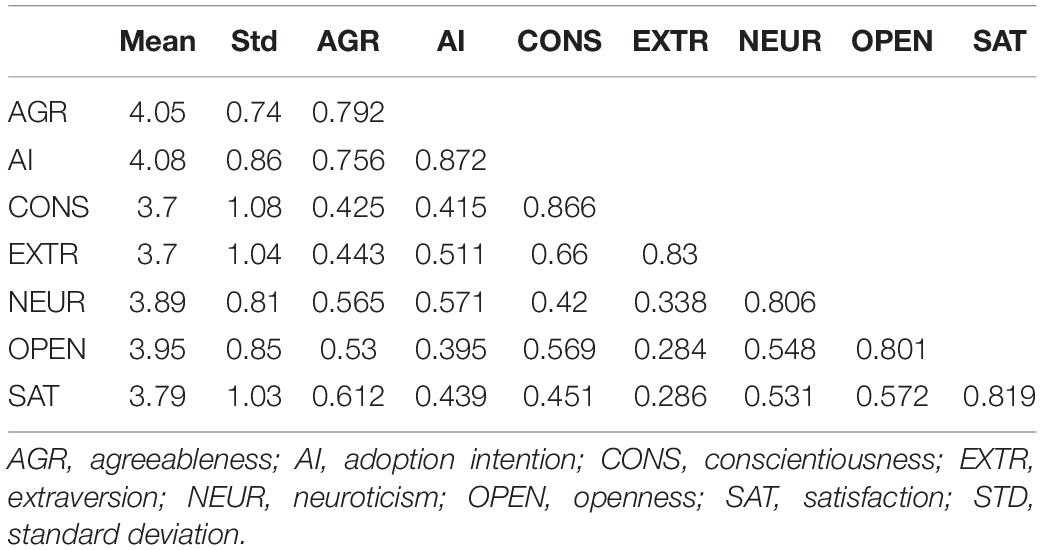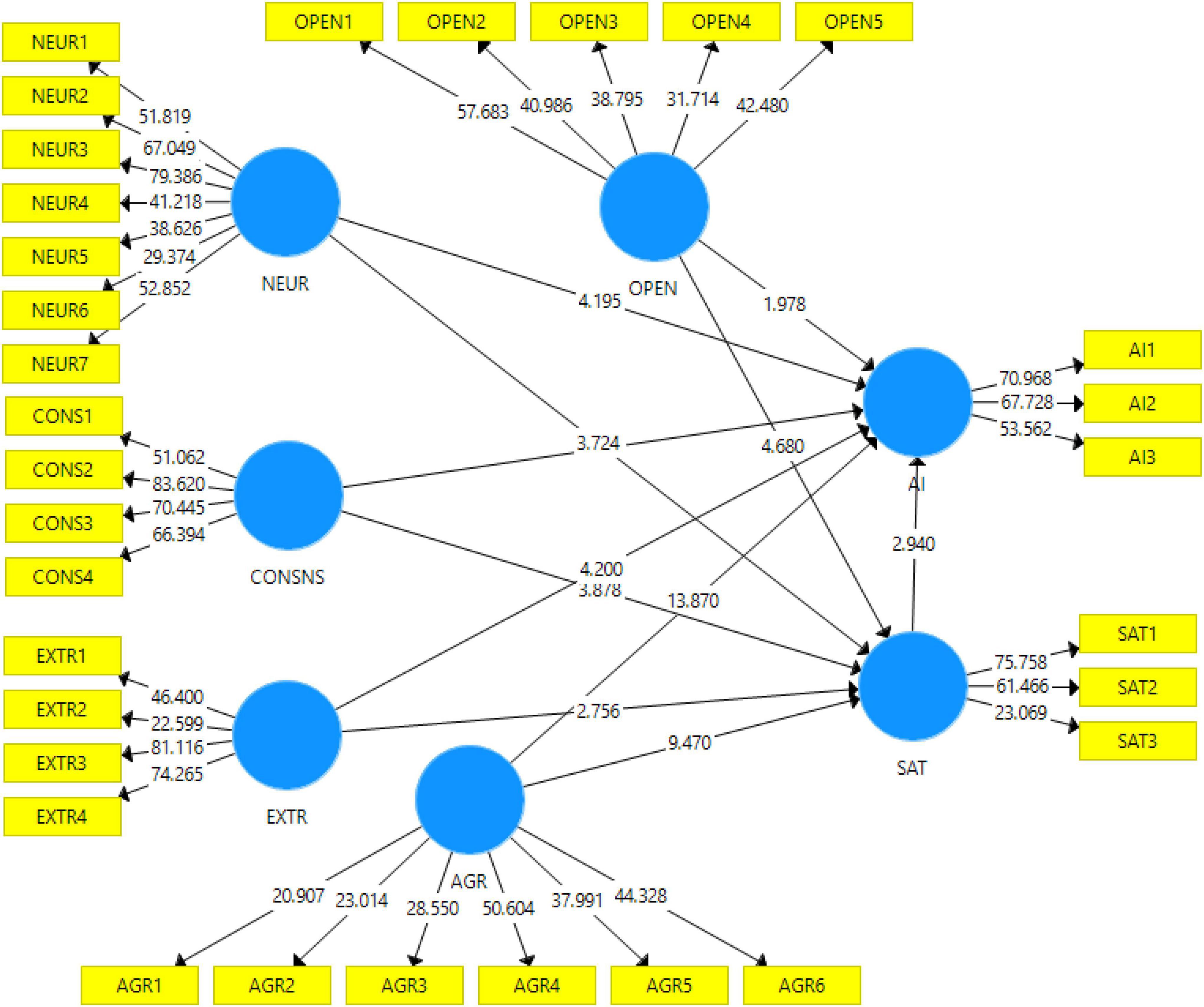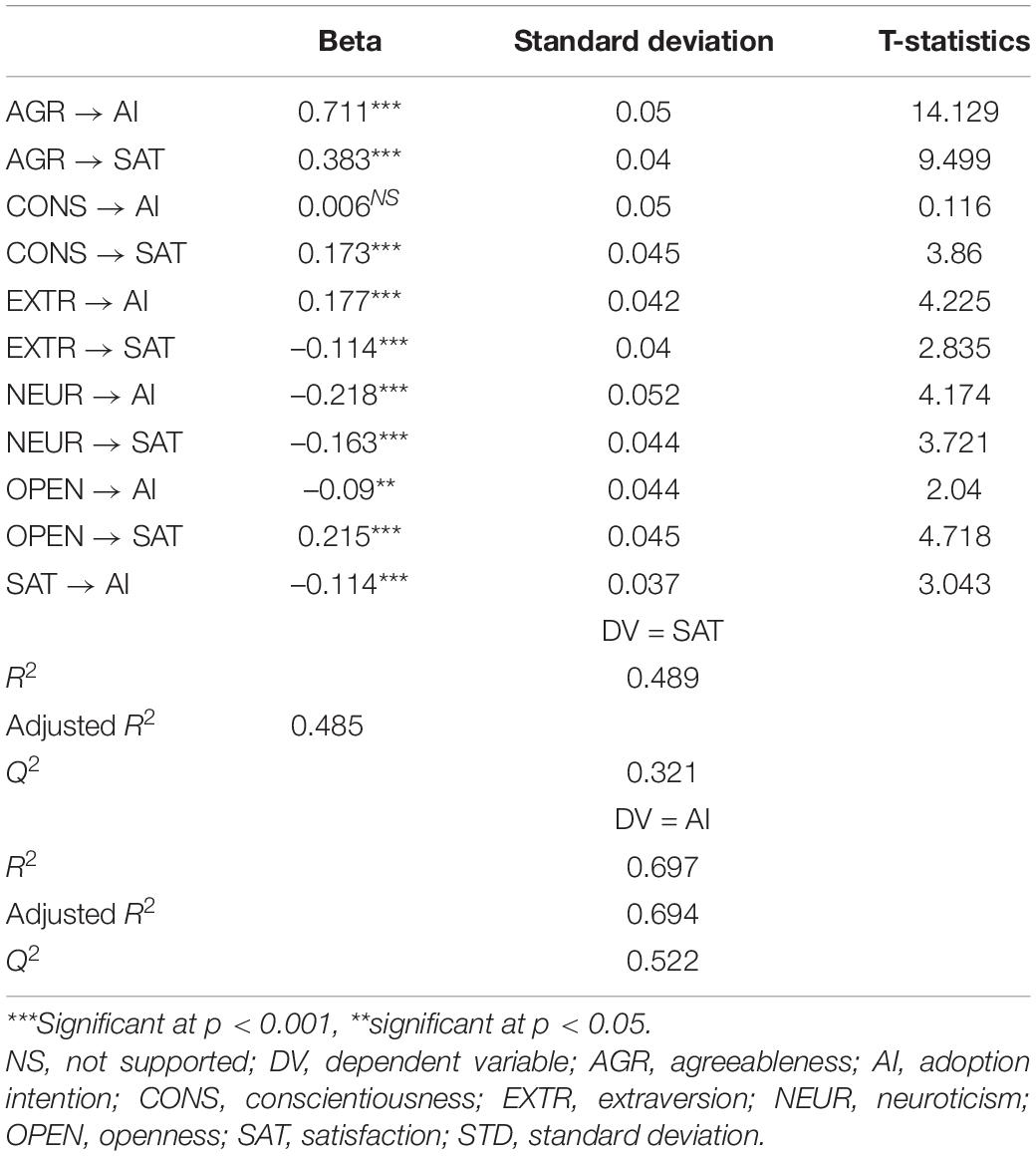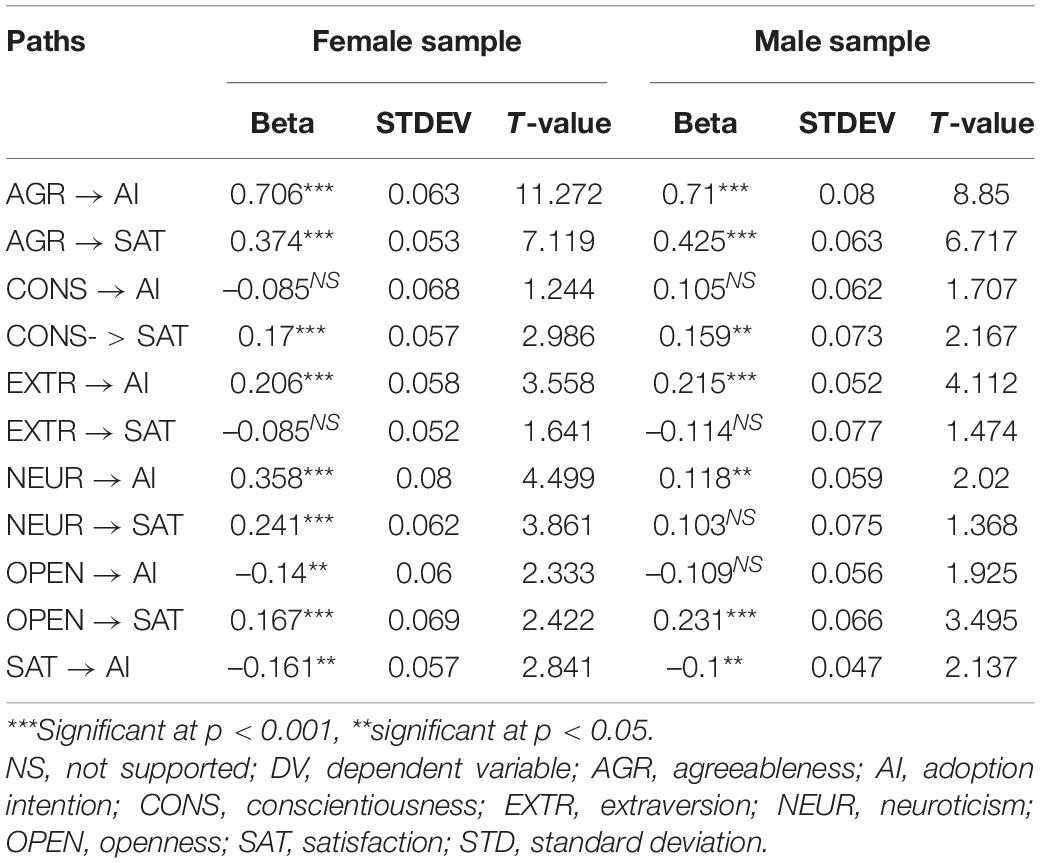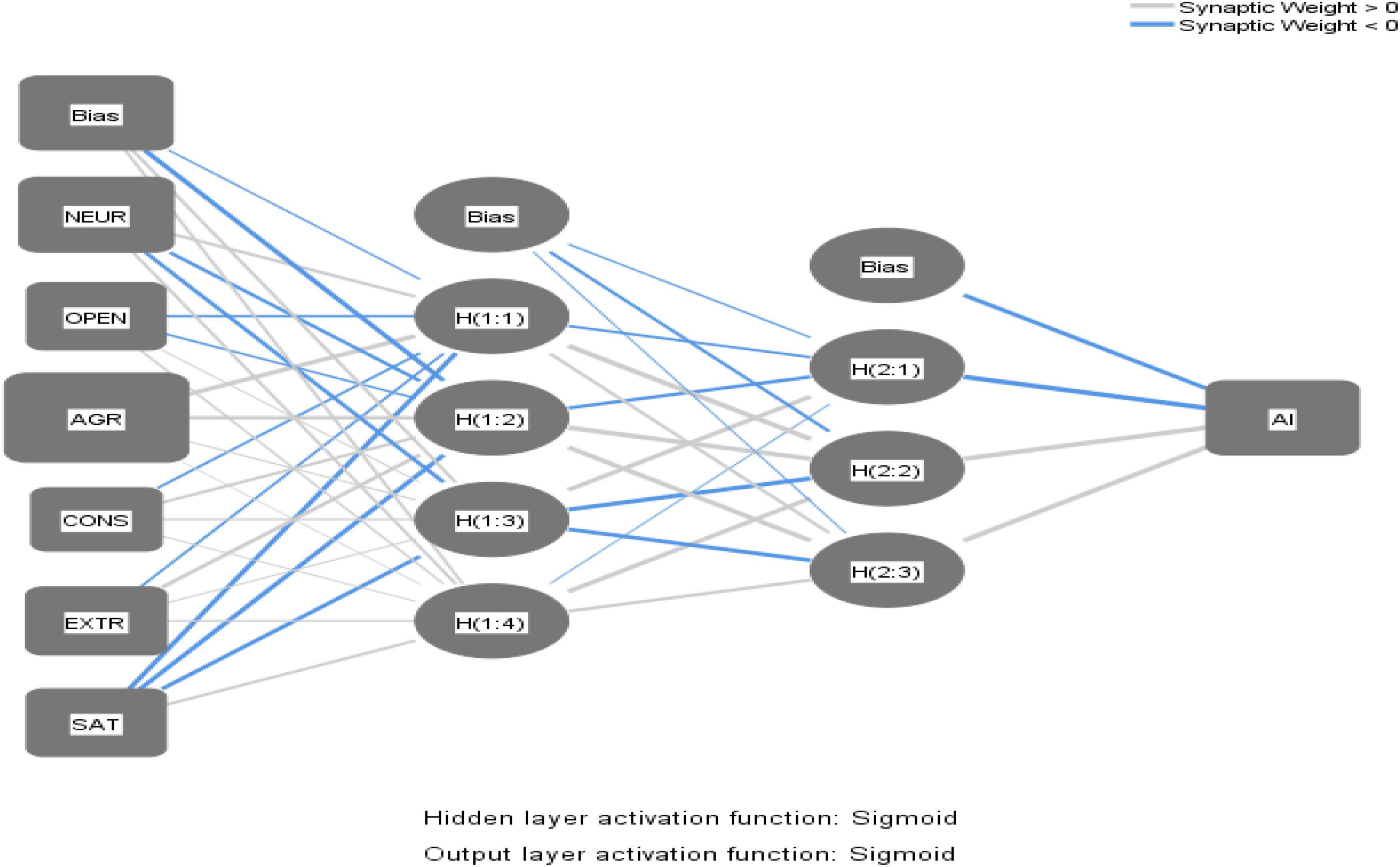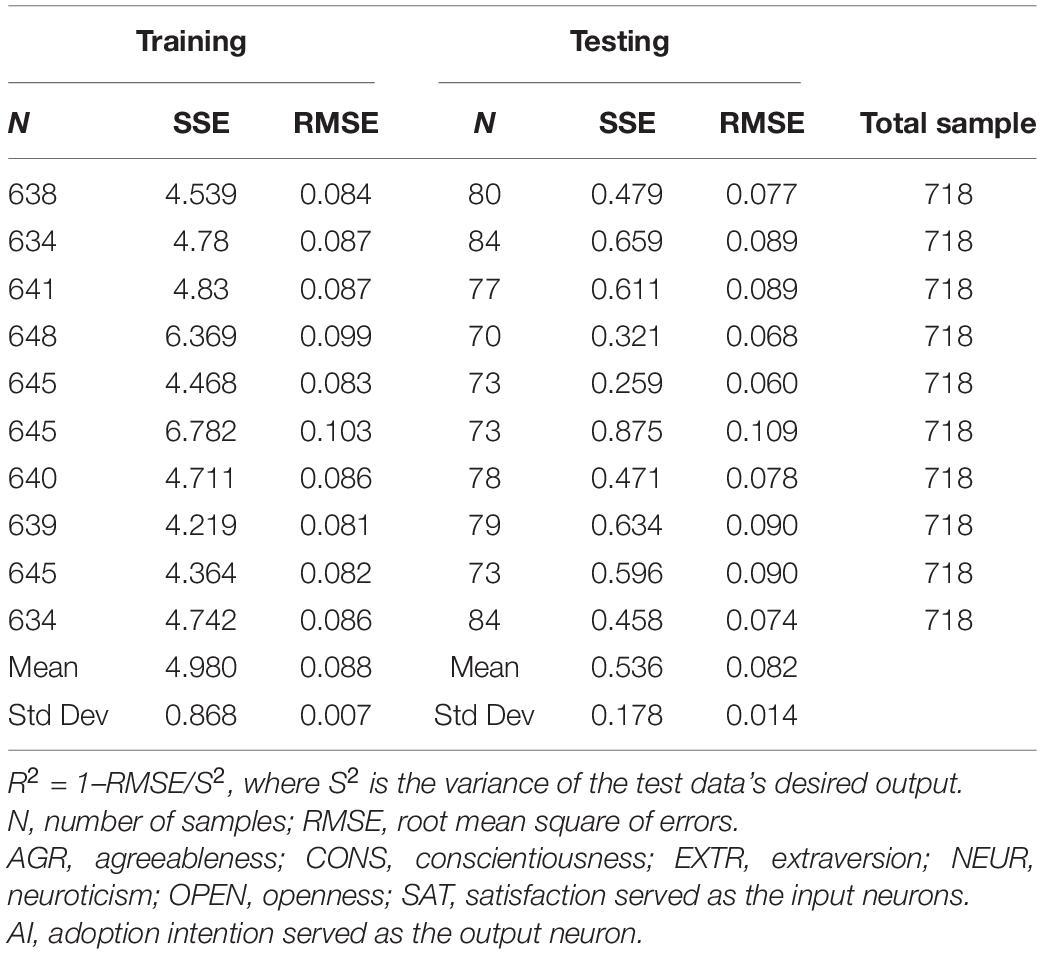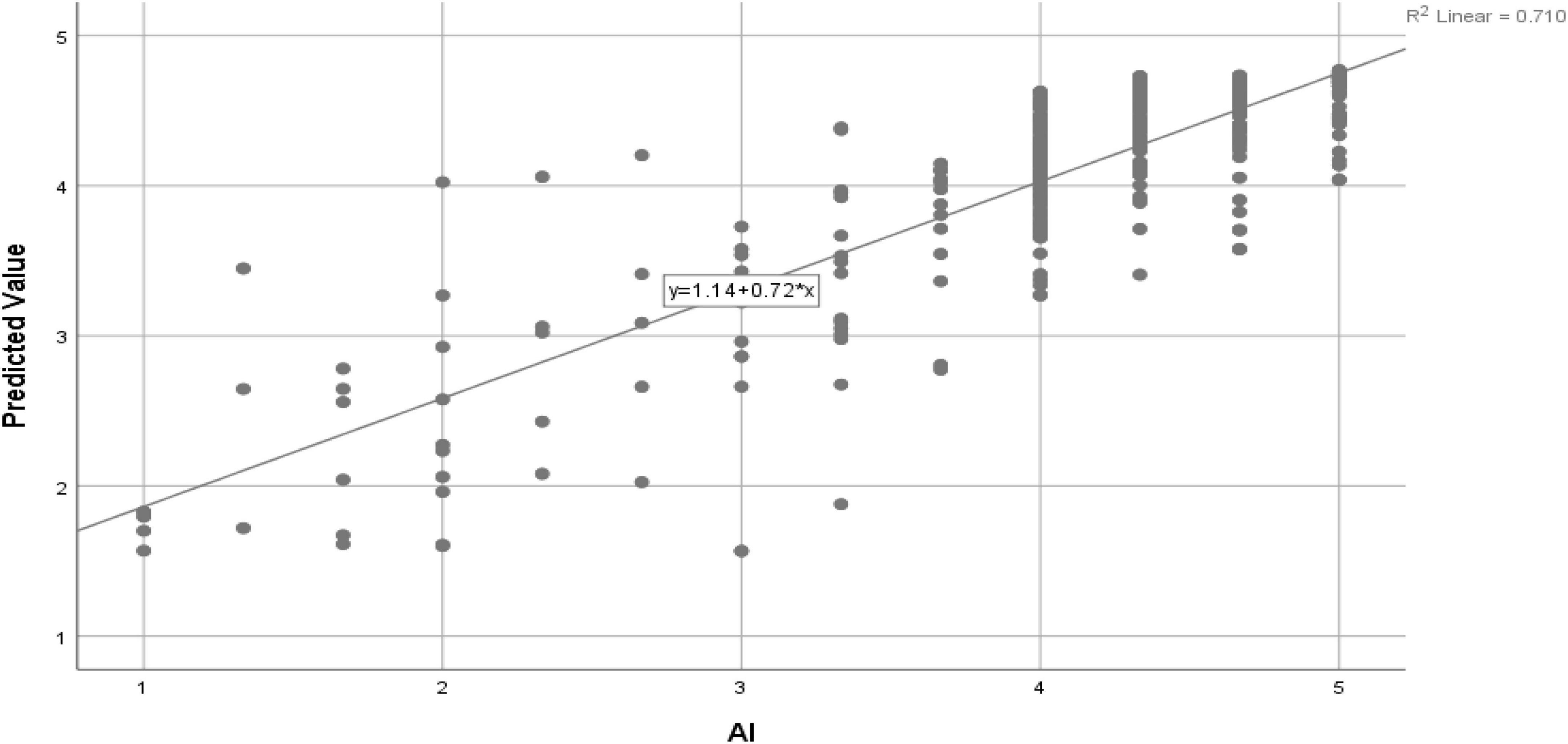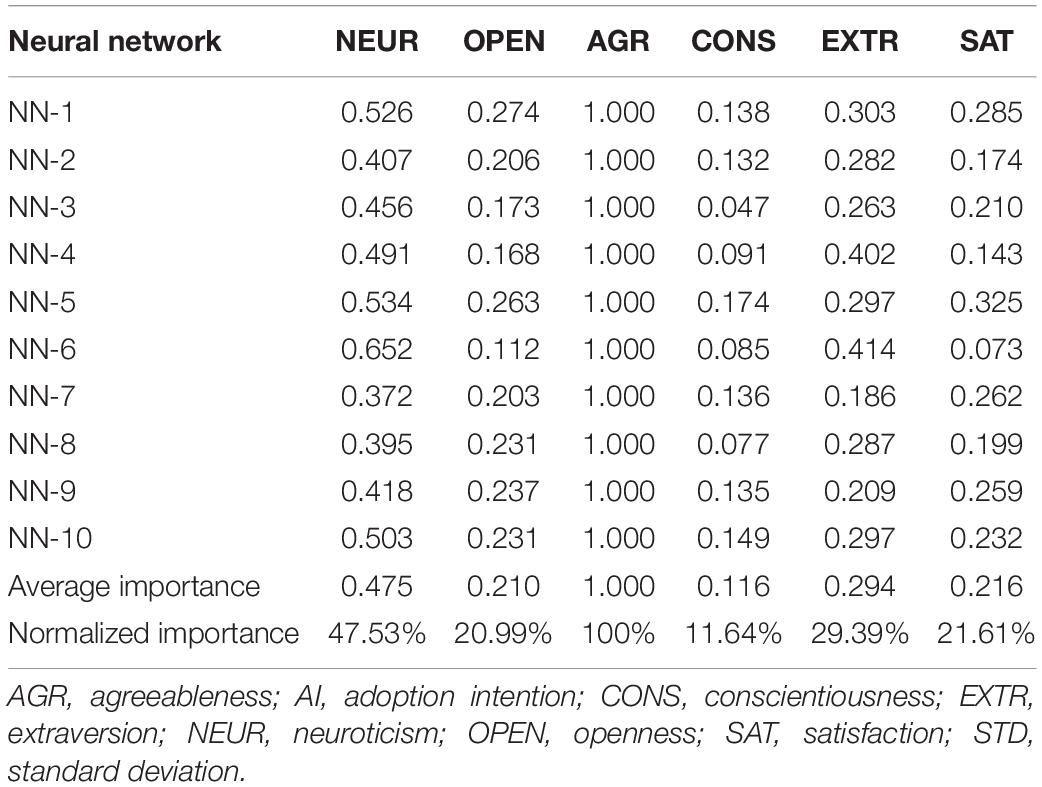- 1College of Economics and Management, Beijing University of Technology, Beijing, China
- 2Faculty of Education, University of Malaya, Kuala Lumpur, Malaysia
- 3School of Economics and Management, North China Electric Power University, Beijing, China
- 4Asia-Europe Institute, University of Malaya, Kuala Lumpur, Malaysia
- 5Government Islamia Graduate College for Women, Faisalabad, Pakistan
During the COVID-19 pandemic, online teaching modes were found vital to continue students’ learning process, but sustainable implementation of online teaching models is an area of concern for policymakers. Psychiatrists are also eager to know students’ behavior toward learning and modes of teaching during COVID-19. We have drawn a model based on the big five personality traits to study students’ satisfaction with online teaching modes and their adoption intentions toward online teaching modes. We have collected data from 718 bachelor’s and master’s level students from four different universities. We have applied the SEM-ANN dual-stage approach to test personality traits’ influence and ranked them based on their normalized importance. The results revealed that agreeableness, conscientiousness, neuroticism, and openness positively influence students’ satisfaction with online teaching models, but that extraversion negatively influences their satisfaction. Agreeableness, extraversion, and neuroticism positively impact, but openness negatively influences. Conscientiousness does not affect adoption intention. Furthermore, agreeableness is the most significant, and conscientiousness is the least important factor for students to adopt online teaching modes. The findings of the study have useful perceptiveness for educational policymakers, academics, and psychiatrists.
Introduction
Online learning through digital modes of teaching is prevailing since the revalorization of the IT sector and frequent use of the Internet. During COVID-19, students around the globe were offered to learn from home through online classes. It is mainly to control the spread of COVID-19 and keep the smooth learning process of students so their studies do not get disrupted.
Students who take up full-time teaching courses and enrolled in different universities generally have never encountered such kind of online classroom environment. They were not used to the mode of online teaching. It has some interesting outcomes, and students behave differently toward adopting the new teaching model. Students of courses that need physical encounters in laboratory works (medical, biomedical sciences, civil, mechanical, electrical, chemical, and material engineering) were less satisfied than those with no laboratory works (education, social sciences and humanities, accounting, and economics) (Eckhaus and Davidovitch, 2021). Furthermore, it has been observed that majority of students do not like online or E-teaching alone. This is most likely the case because of lack of social engagement. According to a recent survey in India, eighty percent of students believe that face-to-face learning is essential for practical learning, and seventy-seven percent of students believe that a classroom is a place for learning that is superior to other types of learning environments (Radha et al., 2020). The future of medical education lies in hybrid or blended learning, since it is more student-friendly and efficient (Hameed et al., 2020).
Researchers believe that satisfaction from a teaching mode or inclination toward its adoption or rejection is related to individual personality traits (Varela et al., 2012; Eckhaus and Davidovitch, 2021). Personality traits play a significant role in human decision-making (Irfan and Ahmad, 2021). It is also believed that online teaching and learning in an online mode are significantly associated with adopters’ perceptions. Students perceive it differently. It also affects students learning capacity and outcome (Coenen et al., 2021; Mateus et al., 2021; Rafique et al., 2021).
Recent studies have studied personality traits in different circumstances related to learning and education, such as online learning in the management field (Varela et al., 2012), Satisfaction from Online Teaching (Eckhaus and Davidovitch, 2021); still, they ignore the personality traits and their role in students satisfaction from online teaching mode and its adoption. Researchers have also studied the video conference mode of teaching in Vietnam and collected data from instructors, and measured the acceptance and use intention of a video conference (Nguyen and Nguyen, 2021); the same study is carried out in Pakistan (Akram et al., 2021), but they ignore the role of personality traits. They did not involve students in their study to understand their satisfaction with and adoption intention to online teaching modes.
Other studies have studied personality traits not in the context of online learning platforms but to learn the secondary level of students’ grade performance (Meyer et al., 2019) or personality traits’ role in satisfaction with training and vocational education (Volodina et al., 2019).
In addition to this, most studies have applied multivariate models such as SEM to conclude their results (Volodina et al., 2019; Akram et al., 2021; Nguyen and Nguyen, 2021), but researchers have suggested implementing dual-stage SEM-ANN models in studies that involve human psychology (Mustafa et al., 2021), because they provide a better picture of phenomena. Furthermore, study results of the first step (SEM) show a negative relationship between satisfaction and adoption intention that motivates us to carry on an ANN analysis to dig deeper on data and find a possible justification behind the surprising results.
With this brief discussion on the recently available literature, we have found a research gap that none of the recent studies involved students in studying their psychological state of mind toward satisfaction with online teaching modes or measured the intention to adopt online teaching modes in the future. Furthermore, the role of personality traits as significant antecedents of human decision-making has been ignored in recent studies. Hence, we have proposed the following research questions to fill this research gap.
RQ1: Do students’ personality traits play a significant role in their satisfaction with the online teaching model and its adoption in the future?
RQ2: What are the most significant (importance wise) personality traits in students’ online teaching model adoption?
This study is one of the first to examine students’ personality traits that influence their satisfaction with online learning and their adoption intentions of the online learning model in the future. To answer the research questions based on the five-factor theory, we have proposed a model and empirically tested it using a two-stage hybrid model, SEM-ANN. Apart from this, we have also examined gender-specific paths to understand the gender difference in online teaching models adoption, and personality traits that influence male and female segments. We have selected China to test our proposed model and collected data from four universities in China. The study results based on SEM (RQ1) revealed that agreeableness, conscientiousness, neuroticism, and openness positively influence students’ satisfaction with online teaching models, and that extraversion negatively influences it. For the adoption intention of these modes in the future, agreeableness, extraversion, and neuroticism positively influence, but openness negatively influences. Conscientiousness does not affect adoption intention. In response to RQ2, a sensitivity analysis revealed that agreeableness is the most significant predictor according to the normalized importance of variables, followed by neuroticism and extraversion. The study findings have beneficial implications for researchers and psychiatrists to understand students’ psyche. They also yield practical implications for policymakers for students.
Theoretical Framework
Five-Factor Theory
The foundation of the five-factor model (McCrae and Costa, 1992) is laid on personality characteristics that serve as fundamental components of an individual’s character. The model comprises five personality traits: conscientiousness, neuroticism, agreeableness, extraversion, and openness to experience. Conscientiousness is linked to a nature that is more goal-oriented, organized, determined, perseverant, and dedicated, whereas neuroticism is related to feelings of insecurity, distress, guilt, anger, depression, anxiety, and aggression (Talwar et al., 2022). Neuroticism is a negative emotional state that leads to emotional instability (Talwar et al., 2022). Next, extraversion is linked to qualities like expressiveness, sociability, and outgoingness, while openness to experience is connected with qualities such as creativity, curiosity, imagination, and a broad-minded mindset. In conclusion, agreeableness is connected to characteristics such as compassion, caring, generosity, trust, and cooperativeness. In a further development of the paradigm (Olson and Evans, 1999), noted that people’s emotions are influenced by their levels of extraversion and neuroticism, while their levels of Agreeableness, Conscientiousness, and Openness to experience, impact their cognitive processes. Based on the five-factor theory, we have developed a model to understand students’ satisfaction from the online class model and their intentions to adopt this teaching model in the future. It will explain students psyche toward online delivery of lectures and learning through online modes of teaching during COVID-19. We have proposed the following conceptual framework to study the subject.
Literature Review and Hypothesis Development
The level of academic performance has been evaluated based on a variety of different variables (Gladius Jennifer et al., 2018; Mahmoodi et al., 2019; Belsare et al., 2020; Mateus et al., 2021), but the focus is typically placed on sociological ones such as the environment or the dynamics of the family, psycho-pedagogical ones such as study habits or attitudes toward the university, and purely psychological ones such as cognitive processes or personality. According to the findings, academic success is related to intellectual characteristics, but it is also an impact of a multitude of adaptative, behavioral, and psychopathological variables, including certain personality traits (Mateus et al., 2021). Recent studies have studied the influence of personality traits on preferences and educational choices (Coenen et al., 2021), personality traits and burnout (Narang et al., 2022), academic performance in higher education (Mateus et al., 2021), domain-specific achievement (Meyer et al., 2019), satisfaction with training and vocational education (Volodina et al., 2019), education and biosecurity compliance (Racicot et al., 2012), associations among gender, education, religious faith, and social class personality traits (Furnham and Cheng, 2015), early childhood pedagogies and views about education (Smidt et al., 2015), students’ use of YouTube for educational purposes during the course of COVID-19 (Elareshi et al., 2022), and so on. Still, none of the studies have investigated the effect of students’ personality traits on their satisfaction with and adoption of online teaching modes offered during COVID-19. To fill this research gap, we have proposed the conceptual model presented in Figure 1.
Agreeableness
As a behavioral trait, “agreeableness” indicates a person’s prosocial attitude, commitment, and responsiveness (Irfan and Ahmad, 2021). When it comes to controlling emotions in interpersonal situations, it is especially concerned with “belonging,” a framework that encourages tight ties and provides social support (Talwar et al., 2022). Therefore, agreeableness is a reflection of individual variances in prosocial and communicative inclinations, which may range from warmth and attachment to animosity and antagonism (Shiner and Masten, 2008). People who have high agreeableness to disagreeability ratio are polite. They have a goal of maintaining uniformity even if doing so would be detrimental to their interests. An agreeable person is trustworthy, kind, and avoids arguments to foster a healthy learning environment. Agreeableness is related to interpersonal skills and characterizes someone who tends to be agreeable (Irfan and Ahmad, 2021). Thus, they behave like a group and are open to new technologies (Irfan and Ahmad, 2022). Recent studies stated that agreeableness is the best predictor of mathematics, science, engineering, and technology specialization and preferences (Coenen et al., 2021). In another study, a negative correlation was found between agreeableness and students’ grades across both genders (Meyer et al., 2019). Researchers have also figured out that agreeableness is positively correlated with vocational education and training satisfaction (Volodina et al., 2019). Another study in British found a significant correlation between agreeableness and both religious background and frequency of religious service attendance (Furnham and Cheng, 2015). Another study in Germany found that respondents who scored higher on the agreeableness scale had a greater chance of belonging to the ambitious profile than those who scored higher on the moderate scale (Smidt et al., 2015; Wang and Sohail, 2022). With this discussion, we have hypothesized that:
H1a: Students’ agreeableness personality trait will positively influence their satisfaction with online learning/teaching modes during COVID-19.
H1b: Students’ agreeableness personality traits will positively influence their adoption intention of online learning/teaching modes during COVID-19.
Conscientiousness
A person’s propensity to be responsible, well-organized, and self-disciplined is what is meant to be understood when talking about their conscientiousness. People who demonstrate the attribute of conscientiousness are more likely to participate in administrative activities. They will not give up on pursuing their objectives no matter how much effort or time is necessary (Irfan and Ahmad, 2021). These people are more likely to gather accurate and relevant knowledge and have a greater propensity to work hard to achieve their goals (Irfan and Ahmad, 2022). Those who scored higher on both the conscientiousness and openness scales had a greater likelihood of being categorized as ambitious than those who are reserved (Smidt et al., 2015). Another study in British revealed a significant correlation between conscientiousness and both religious background and frequency of religious service attendance (Furnham and Cheng, 2015). Researchers have also claimed that conscientiousness positively influences training and vocational education satisfaction (Volodina et al., 2019). A study on upper secondary education in Germany revealed no correlation between conscientiousness and test results in English regardless of the other factors included. Conscientiousness was shown to have substantially favorable benefits in mathematics even after controlling for gender, socioeconomic status, and cognitive ability (Meyer et al., 2019). Although it is generally accepted that conscientiousness is the most important of the big five in terms of school achievement, there is very little correlation between conscientiousness and desire for the science, engineering, technology, or mathematics field as a particular area of concentration (Coenen et al., 2021). With a detailed discussion of recent studies’ results, we proposed the following:
H2a: The conscientiousness trait of students’ personality will positively influence their satisfaction from online teaching/learning modes during COVID-19.
H2b: The conscientiousness trait of students’ personality will positively influence their adoption of online teaching/learning modes during COVID-19.
Extraversion
Extroverts are often self-assured and like being in the company of others. These traits tend to go hand in hand. People that have a high level of extraversion tend to be outgoing, self-assured, and like new experiences (Irfan and Ahmad, 2022). Coenen et al. (2021) claimed that personality characteristics are somewhat less relevant in connection to the actual specialty choice, for which they uncover a strong (and sizeable) negative link with extraversion. They further claim that the best indicator of a person’s true decision in the science, engineering, technology, and mathematics fields is extraversion. A study conducted in Germany by researchers with the aim of “Educational Outcomes of Students from Vocational and Academic Upper Secondary Schools” claims that in all models, extraversion was shown to have a detrimental impact on final mathematics examinations and test scores. None of the models found any statistically significant impacts on English (Meyer et al., 2019).
Furthermore, researchers figured out that the extraversion trait is positively associated with training and vocational education satisfaction (Volodina et al., 2019). The extraversion trait is also found positively significant in religious background and frequency of religious service attendance (Furnham and Cheng, 2015). A study conducted in Germany with the title of “Relations between the Big Five personality traits of prospective early childhood pedagogues and their beliefs about the education of preschool children” found an insignificant relationship of the extraversion trait (Smidt et al., 2015). With this literature, we proposed that:
H3a: The extraversion trait of students’ personality will negatively influence their satisfaction from online teaching/learning modes during COVID-19.
H3b: The extraversion trait of students’ personality will positively influence their adoption intention of online teaching/learning modes during COVID-19.
Neuroticism
The term “neuroticism” refers to distressing emotions including sadness, agony, frustration, dread, and unease (Nagel et al., 2018). People who suffer from neurosis are more sensitive to effects of external stimuli and have a propensity to overreact to ordinary events. They become more anxious as a consequence of these stimuli, which leads to decline in cognitive activities and increased vulnerability to stress (Irfan and Ahmad, 2022). A study revealed that people who exhibited neuroticism had a greater likelihood of being part of the ambitious profile with strong endorsements of educational ideas (Smidt et al., 2015; Yen et al., 2018). Neuroticism showed a negative relationship with religious background, frequency of religious service attendance (Furnham and Cheng, 2015), and training and vocational education satisfaction (Volodina et al., 2019), but had educational choices and preferences in the science, engineering, technology, and mathematics fields (Coenen et al., 2021). However, researchers measuring “domain-specific achievement in upper secondary education” in Germany claimed that English grade and overall grade point average demonstrated favorable associations with neuroticism. This might be connected to the more meticulous learning behavior connected with neuroticism, which is advantageous for cumulative evaluation but not for direct testing scenarios. On the other hand, direct testing settings can be beneficial for cumulative assessment (Meyer et al., 2019). We also suggest that negative emotions may lead to a negative outcome from the students’ perspective, and we hypothesize that:
H4a: The neuroticism trait of students’ personality will negatively influence their satisfaction from online teaching/learning modes during COVID-19.
H4b: The neuroticism trait of students’ personality will negatively influence their adoption intention of online teaching/learning modes during COVID-19.
Openness
Studies on people’s personalities have shown that openness is a good indicator of whether or not they are likely to be inventive, progressive, or adventurous (Stajkovic et al., 2018). They are naturally inquisitive and eager to acquire new knowledge, which enables them to provide fresh ideas and points of view. Openness to experience and agreeableness with others have been shown to be the greatest indicators of preferences in technical fields (Coenen et al., 2021). A study conducted at a Colombian university did not find any clue of a significant relationship between openness and academic performance in higher education (Sohail and Delin, 2013; Mateus et al., 2021). Another study found a strong positive correlation between openness to experience and satisfaction with training and vocational education; however, there was no correlation between openness to experience and overall life satisfaction (Volodina et al., 2019). A British cohort was studied to investigate associations between openness qualities, religious beliefs, and service attendance (Furnham and Cheng, 2015), and researchers found a negative association between openness with outcomes. With discussion of the literature, we suggest that openness to experience will lead to higher satisfaction as students explore new means of learning that can lead to their learning satisfaction during COVID-19. Keeping in mind the circumstances of COVID-19, the adoption intention may not be favorable because students who took classes that required physical encounters in the form of laboratory works (such as medical, biomedical sciences, civil, mechanical, electrical, chemical, and material engineering) reported lower levels of satisfaction than students who took classes that did not require laboratory works (such as education, social sciences and humanities, accounting, and economics) (Eckhaus and Davidovitch, 2021). Hence, we hypothesize that:
H5a: The openness to experience trait of students’ personality will positively influence their satisfaction from online teaching/learning modes during COVID-19.
H5b: The openness to experience trait of students’ personality will negatively influence their adoption intention of online teaching/learning modes during COVID-19.
Satisfaction and Adoption Intention
Satisfaction from technology leads to adoption and use of technology or product. Researchers have found that satisfaction from 5G services leads to their adoption in the future (Mustafa et al., 2022d), electronic gadgets (Mustafa et al., 2022a), electronic vehicle adoption (Mustafa et al., 2021), the effect of climate change and adoption techniques to minimize risk (Sohail et al., 2022b), green transportation adoption (Sohail et al., 2021). Furthermore, researchers have revealed that the level of satisfaction experienced by users will have a favorable and substantial influence on their desire to continue using academic library applications (Rafique et al., 2021). Satisfaction from training and vocational education leads to life satisfaction (Volodina et al., 2019), but students that engage in degrees/courses that require practical work may not like to use them in the future because of their learning requirements (Eckhaus and Davidovitch, 2021). Hence, we suggest that satisfaction from online learning modes may or may not influence students to use them in the future. Hence we propose:
H6: Satisfaction from online teaching/learning platforms during the COVID-19 period will influence their adoption intention in future.
Gender Influence
We have decided to study gender-specific paths to clarify the role of personality traits in online teaching/learning mode’s satisfaction and adoption. Male and females differently perceive things and have different psych toward adopting a technology (Mustafa et al., 2022a) and contributing knowledge to online Q and A communities (Mustafa and Wen, 2022; Mustafa et al., 2022c). The same is found in the case of personality traits; gender differences in personality traits and the influence of personality traits are different for men and women (Narang et al., 2022). A significant gender difference is found in a study conducted at a Colombian university to measure academic performance in higher education (Mateus et al., 2021). Hence, we suggest that there might be a different influence of personality traits in our study.
Methodology
Research Context
To test our proposed model and check the influence of the big five personality traits on satisfaction and adoption intention of online learning modes, we picked four universities in China. It was estimated that there would be 2,738 public colleges and universities in China in the year 2020. There were 1,270 universities and 1,468 higher vocational colleges included in this total (Statista, 2022). In China’s public universities and colleges in the year 2020, there were around 33 million students enrolled in undergraduate degree programs. It was estimated that 18.3 million of them were enrolled in bachelor’s degree programs, and that the remaining 14.6 million were enrolled in short-cycle degree programs that were more realistically oriented (Statista, 2021; Li et al., 2022). Hence, these incredible statistics encourage us to study personality traits that influence E-learning adoption and student satisfaction from these modes in China.
Construction of Instrument and Sample Collection
We employed a construct that has been shown useful in past studies. Supplementary Material fully describes each measuring item’s configuration and characteristics. We make very few adjustments to the ideas for our research constructs so that they may better serve the objective of our investigation. We discussed the instrument with three academics who are specialists in the field, and we included all of their insights. After that, we conducted a pilot study to determine respondents’ time answering a questionnaire and their comments. Thirty graduate students (master’s and bachelor’s) were selected to participate in the pilot study. Throughout the pilot study, we talked with academic specialists to include any new content necessary to clearly understand student’s behavior. In the next stage, we collaborate with two translators fluent in Chinese. Language specialists adapt the English version of the instrument for use in the Chinese language. After that, we retranslate the instrument into English to determine whether or not the newly translated version properly calculates the same answer as the instrument’s initial version. Again, academic specialists were engaged to ensure that the translated version of the instrument included the same importance in both English and Chinese when it came to the construct items. In the end, fifteen Chinese students at the master’s level were selected to participate in the final instrument validity. They gave encouraging feedback, and the results of the second phase of the pilot project supported the continuation of the investigation; nevertheless, participants of the pilot study were not included in the final sample.
Because of the potential for manual data input and other types of human error, we decided to conduct the poll online. We used a five-point Likert scale to collect the cross-sectional dataset and measure the response of our target population, with 1 representing “strongly disagree” and 5 “strongly agree.” Researchers claim that a five-point Likert scale is easy to manage and less complex than higher-order scales (Awan et al., 2021; Gul et al., 2021). We have randomly picked the Students of Bachler and master’s level enrolled in Beijing University of Technology, Xiangtan University, Wuhan University, and Shanghai Normal University. A total of eight hundred questionnaires via the Chinese star questionnaire1 QR code was shared with students of the economics, computer science, mathematics, and education fields (Two hundred from each university). We received 718 useable samples with a response rate of 89.75%. The sample size of 718 is large enough to carry out further statistical analysis as it has more than 10 responses per item threshold (Yen et al., 2017; Sohail et al., 2022a; Zhongjun et al., 2022).
Demographic of Respondents
We collected basic demographic information about the respondents. Table 1 represents their demographic characteristics.
Common Method Bias
Common method bias (CMB) might result when the same response technique is used to measure the dependent and independent variables. A study’s validity might be jeopardized by common methodological biases. Previous researchers recommend several procedural and statistical measures to avoid CMB (Podsakoff et al., 2012). We informed all the participants about the study’s purpose and use of data. To every respondent, the questionnaire was explained in detail before they responded to it. There were also language experts and academics during the preparation process of the questionnaire to make it clear and easy to understand for the respondents. Before handing over a questionnaire QR code, we explained to the respondents that there were no specific criteria for picking the correct answer. The respondents need to provide their own perceptions and response. We made clear that it will not be treated as wrong or right. In the analysis part, we performed the recommended Harman’s single-factor analysis, and the results revealed that the single factor contains only 37.91% of the total variance, which is far less than the recommended threshold value of 50% (Podsakoff et al., 2012; Mustafa et al., 2022e). Hence, there is no serious threat of CMB existing in our study.
Partial Least Squares Structural Equation Modeling
Partial least squares structural equation modeling was the method that we used since it is the one that is suggested most for usage in situations a the study is focused on predicting and examining dependent variables in order to explain the highest amount of variation. According to Roldán and Sánchez-Franco (2012), the PLS-SEM methodology is the most successful prediction-oriented strategy. In addition to this, it can concurrently process measurement (outer) and structural (inner) models. In addition to this, it is suitable for analysis of intricate route models (Hair et al., 2016). Last but not least, PLS-SEM can work with a very small sample size while producing more accurate findings. As a result, it seems that PLS-SEM is the method that should be used for this investigation. As was recently pointed out by Mustafa et al. (2022d), the PLS-SEM approach is on the rise, which may be attributed to the potential advantages it offers in management science (Mustafa et al., 2021, 2022d). According to Hair et al. (2020), the PLS path modeling approach is evaluated in two stages in order to guarantee that the constructs’ measurements are correct and reliable: (a) the evaluation of the measurement model determines the outer mode’s reliability and validity and (b) the assessment of the structural model defines the inner model or the link among the latent constructs. However, because of the fact that the model incorporates non-linear interactions, it is beneficial to carry out an analysis that consists of two stages.
Multivariate Assumptions
Researchers claim that multivariate assumptions need to test, i.e., linearity, multicollinearity, and homoscedasticity, before performing a multivariate analysis (Mustafa et al., 2021, 2022d). A Kolmogorov-Smirnov (K-S) test was performed with intention of determining whether or not the data follow a normal distribution; however, the findings show that the data do not follow a normal distribution (Hew et al., 2017). Supplementary Material provides evidence for both linear and non-linear interactions that take place between dependent and independent variables. Last but not least, VIF scores were examined in order to determine whether or not the model had any collinearity issues. According to the findings of this research, all of the variables have VIF values that are less than 5 (Table 2). According to Hair et al. (2016), VIF values lower than 5 indicate no collinearity problems associated with a dataset. The indicators’ loadings and cross-loadings can be found in the Supplementary Material.
Measurement Model
According to what was found in the study (Hair et al., 2016; Jamil et al., 2022), the reliability of the indicator, construct convergent validity, and discriminant validity should be used to evaluate measurement models. Cronbach’s Alpha (α) and indication loading was used in the process of determining the instrument’s level of reliability. Convergent validity testing was performed on the indicators of the constructs to see whether or not they provide an accurate assessment of the research variables. AVE is an abbreviation for the total amount of variation in indicators that was compensated for by the latent construct, and CR is an abbreviation that describes the consistency of the variables. The reliabilities of the individual items are presented in Table 2, and their reliability is evaluated based on the factor loadings of the items on the respective constructs. For a component to be deemed significant and be included in the model, its factor loading must be equal to or higher than 0.6 (Hair et al., 2016; Jamil et al., 2021). In addition, the significance of Cronbach’s Alpha for all constructs is higher than or very near to the acceptable threshold of 0.7 (Werts et al., 1974).
Additionally, the constructs’ composite reliability (CR) was evaluated because it is generally accepted that CR is a more effective tool for measuring reliability than Cronbach’s alpha (Werts et al., 1974). The fact that the CR values of constructs are all higher than 0.7 is an additional factor that strengthens the reliability of the variables. Concurrently, the estimates for the convergent validity of the average variance extracted (AVE) were all higher than 0.5, proving that convergent validity had been achieved (Table 2; Hair et al., 2016).
Finally, the Fornell–Larcker criterion is used so that the discriminant validity of the model may be evaluated. Table 3 shows that discriminant validity has been established in accordance with the Fornell–Larcker criterion. This is shown by the fact that the top value of the association of measures is greatest in each column (Fornell and Larcker, 1981; Hair et al., 2016).
Structural Model Assessment
Assessment of the structural model is the second step in the PLS-SEM evaluation process. In order to evaluate a structural path model, it is necessary to evaluate the multicollinearity of data and the predictive relevance of the model, empirical significance of path coefficients, and degree of confidence (Hair et al., 2016). In the current research, general guidelines were used for the purpose of analyzing the structural model and interpreting the data (Hair et al., 2016).
In our scenario, there are two different endogenous constructs (Figure 2). Hence the PLS-SEM path analysis results revealed that for satisfaction, the R2 value is 0.489 (Q2 = 0.321), and for adoption intention, R2 is.697 (Q2 = 0.522). Our model explains the 48.9% variance caused by the independent variables in satisfaction and 69.7% in AI (Table 4). Predictive relevance is measured by Q2, which indicates whether or not a model has predictive relevance. In our model, the Q2 values indicate that the predictive relevance of the endogenous constructs is established.
In order to evaluate the established hypotheses, we first examined the direct correlations between the variables and then conducted a bootstrapping test with 5,000 replicates following Mustafa et al. (2021) and Mustafa et al. (2022d). The results revealed the AGR (β = 0.711; p < 0.001) for AI and (β = 0.383; p < 0.001) for SAT, CON (β = 0.006; p = 0.908) for AI and (β = 0.173; p < 0.001) SAT, EXTR (β = 0.0.177; p < 0.001) for AI and (β = –0.114; p = 0.005) for SAT, NEUR (β = 0.218; p < 0.001) for AI and (β = 0.163; p < 0.001) SAT, OPEN (β = –0.09; p = 0.041) for AI and (β = 0.215; p < 0.001) for SAT, and SAT (β = –0.114; p = 0.002) for AI. These confirmed the proposed hypotheses H1a, H1b, H2b, H3a, H3b, H4a, H4b, H5a, H5b, and H6, and only H2a is rejected (Table 4).
Furthermore, to access the group-specific effects for both genders, we conducted PLS-MGA and reported the bootstrapped results for men and women individually. We used conducted 5000 resampling in bootstrapping to ensure the architecture in this model is the same as that in model 1.
The results presented in Table 5 for both genders reveal that CONS has no influence on AI, and that EXTR has no influence on SAT (for both genders). At the same time, NEUR does not influence male students’ satisfaction, and OPEN influences male students’ adoption intention. The rest of the relationships was found to be significant for both genders.
Artificial Neural Network
An ANN is a non-linear statistical data simulation tool that can be trained several times to enhance model performance (Mustafa et al., 2022b). An ANN is used for prediction and categorization of data. ANN models are better than other multivariate models in prediction, but they are not suitable for testing hypotheses because of the presence of “BLACBOX” (Mustafa et al., 2021; Talwar et al., 2022). Researcher claim that an ANN can be combined with SEM to achieve better and more reliable results, especially if multivariate assumptions are violated or the sample size is small because an ANN does not need any multivariate assumption and works perfectly with a low dataset. As observed (Supplementary Material), the dataset has some non-linear interaction, so it is better for two-stage analysis. In addition to this, in response to RQ2, we want to rank the predictors according to their normalized importance by sensitivity analysis for students’ E-learning mode adoption intention; hence, we used an ANN in the second stage of the analysis.
We constructed an ANN model for AI, and we picked the sigmoid as the activation function and two hidden layers for neurons following early researchers (Mustafa et al., 2021; Figure 3). In order to prevent over-fitting the model, a method called 10-fold cross-validation was used, and 90 percent of the data were used for training while only 10 percent was used for testing (Table 6).
Table 6 presents the root mean square of errors (RMSEs). An RMSE represents the predictive power of a model (Mustafa et al., 2022b; Talwar et al., 2022). In our model, the RMSE values (Table 6) for training (mean = 0.088, STD = 0.007) and testing (mean = 0.082, STD = 0.014) represent the high predictive power of the constructed ANN model for AI.
In addition, to evaluate the efficiency of the ANN models, we determined a goodness-of-fit coefficient analogous to the R2 value found in the regression models based on a specific methodology (Figure 4).
Sensitivity Analysis
A sensitivity analysis was carried out by making use of the ANN model, and the outcomes are presented in Table 7. The importance of the inputs was validated by the hidden layer of the neural model, which had synaptic weights that were not zero. The output of the model is very sensitive to changes in the values of the various inputs, which are then used to determine the “relative significance” of each factor. We were able to determine the normalized relevance of each variable with the assistance of these findings by conducting a ratio calculation with regard to the value that was found to be the highest overall. The findings of the sensitivity analysis are provided in Table 7.
Based on the sensitivity analysis results presented in Table 7, agreeableness, with normalized importance of 100%, is ranked first, followed by neuroticism (47.53%) and extraversion (29.39%), while conscientiousness (11.64%), openness (20.99%), and satisfaction (21.61%) are least important factors for student adoption intention.
Discussion
This study aims to analyze the influence of personality traits (big five) on students’ satisfaction with online teaching modes and their adoption intention for educational policymakers and psychiatrists to understand the students’ psyche during COVID-19 and the influence of online teaching modes on their output. We have presented a model based on the big five personality traits. We have used an SEM-ANN hybrid model to test the proposed hypothesis (RQ1) and rank the variables according to their normalized importance (RQ2).
H1a–H6 measure the direct effect of understudy variables on students’ satisfaction with online teaching modes and their adoption intentions in the future. H1a presents the relationship between agreeableness and students’ satisfaction with online teaching models, while H1b presents the relationship between agreeableness and adoption intention. The study results revealed that agreeableness has a significant positive relationship with both. With this, we can conclude that students’ personality aspects of inclination, proactiveness, and attentiveness urge them to use online modes during COVID-19 and avoid possible loss of learning during the period. Students act responsibly and adopt new means of teaching to carry on in a healthy learning environment. It is consistent with earlier studies (Volodina et al., 2019; Coenen et al., 2021) but contradicts studies that claim it negatively impacts students’ grades (Meyer et al., 2019). H2a and H2b present the relationship between conscientiousness and students’ satisfaction with online learning modes and their adoption. The results revealed that although conscientiousness has a positive correlation with satisfaction, it does not significantly impact the adoption intention of online teaching modes. It reflects that although students are well-organized and self-disciplined during the COVID-19 period and comply with teaching policies, they are not willing to adopt this method of teaching in the future. It seems realistic, as many students who need a practical work to complete their learning cannot do it online. It is consistent with Volodina et al. (2019) and Coenen et al. (2021). H3a and H3b present the personality trait “extraversion,” which influences students’ satisfaction and adoption intention toward online learning modes. As extravert people like to be in groups and like new experiences, they prefer to study in groups or face to face as they interact with fellow students. This is the reason that the personality trait of being Extraversion negatively correlates with students’ satisfaction with online teaching modes as they have no physical interaction with fellow students, but in the meantime, we have found a positive relationship with adoption intention means Extraversion those like to have new experience and self-assured are more inclined to adopt online teaching mode in future. Possibly they want to find something new and exciting in the online teaching mode. It is consistent with Volodina et al. (2019) but contradicts Meyer et al. (2019). H4a and H4b describe the relationship between neuroticism and explained variables. The results revealed that neuroticism has a negative association with satisfaction with and adoption intention of online teaching modes. Neuroticism represents distressing emotions, and being in isolation during COVID-19 may negatively influence students’ psyche, and they are not satisfied with long-term online teaching without any physical interaction (face-to-face teaching/learning). It negatively influences their intentions to the adopt online mode of teaching. It is consistent with previous studies (Volodina et al., 2019; Coenen et al., 2021). H5a and H5b present the relationship of openness with students’ satisfaction with and adoption intention of online teaching modes. The results revealed that openness positively influences students’ satisfaction but negatively impacts their adoption intention. The possible reason behind the results can be that students who are open to experience are satisfied with online teaching. Still, the influence of neuroticism or other negative states is so high that they do not want to adopt these modes in the future. Finally, H6 presents the influence of satisfaction and adoption intention. Although in previous studies, if users are satisfied with a technology they intend to adopt it (Rafique et al., 2021; Mustafa et al., 2022d). We found surprising results in our study; although the students are satisfied with online teaching modes in given circumstances (COVID-19), they are not willing to adopt the methods of teaching in the future. A possible justification can be that the students want to resume face-to-face classes and physical interactions with peers, and laboratory works. The students believe that online teaching models may not be good in the long run and may result in low learning and less professional training. As indicated in a recent study, 80% of students think face-to-face learning is important for practical learning, and 77% of students prefer a classroom as a better environment for learning (Radha et al., 2020). This is also consistent with ideas presented by earlier researchers (Eckhaus and Davidovitch, 2021).
Furthermore, we conducted PLS-MGA and studied the gender-specific influence of personality traits in male and female students. The results revealed that there is a significant difference between male and female behaviors. Conscientiousness has no influence on adoption intention for both genders, and neither does the trait “extraversion” affect the satisfaction of both genders. We have observed that the effect of extraversion on satisfaction was significant and negative in the overall sample. In addition to this, the female students’ neuroticism positively influences their level of satisfaction for online teaching, but it does not influence the male students. Openness was negatively significant for female students’ adoption intention but did not affect male students’ adoption. We can say that there is a significant difference between male and female students’ behaviors toward satisfaction and adoption, as neuroticism and openness influence the female students but not the male students. It is consistent with the claim of researchers that gender plays a role in students’ performance (Mateus et al., 2021; Narang et al., 2022).
Finally, to answer RQ2, we conducted ANN modeling and a sensitivity analysis to identify the most influential factors behind students’ adoption intention. The sensitivity analysis revealed that agreeableness ranked first, followed by neuroticism and extraversion, and that conscientiousness, openness, and satisfaction are the least important factors for student adoption intention. The ANN results serve as the robustness of the SEM results and provide a clear picture and a deep analysis. We have observed that satisfaction is number four according to its importance for students, which strengthens the results of H6. Furthermore, conscientiousness is the least important among all the traits, which supports our findings of rejection of H2b.
Theoretical Contributions and Suggestions
The study results provide substantial theoretical contributions to the available literature. This study is one of the first to analyze personality traits and their influence on students’ satisfaction with online teaching modes and their intentions to adopt online teaching methods in the future. We have provided new insights into the available literature by incorporating students’ big five personality traits in the context of online teaching modes during COVID-19. We have improved and given a new direction to earlier studies that used personality traits as predictors of human behavior in learning (Volodina et al., 2019; Coenen et al., 2021; Eckhaus and Davidovitch, 2021; Mateus et al., 2021; Nguyen and Nguyen, 2021; Rafique et al., 2021; Narang et al., 2022).
We have provided a new insight into educational psychiatrists that students’ psyche is different during COVID-19, and that they perceive and behave differently toward satisfaction and adoption of online teaching modes. Furthermore, we provided evidence that male and female students’ satisfaction with online teaching modes and their adoption intentions significantly vary with gender.
We have also applied the dual-stage hybrid model (SEM-ANN) and proved that it provides deep insight and robust results; hence, we recommend applying it in human psychology-related studies. Furthermore the ANN model explained the variance much better (71%) than SEM. In the light of the study findings, we suggest that policymakers, academics, and psychiatrists consider the ranking provided in our study to target students’ psyche during COVID-19 and attain better results from online teaching modes by engaging students.
The findings provide a new avenue for policymakers to rethink whether to continue online learning or shift it to a hybrid model if COVID-19 persists. We suggest that policymakers focus on a teaching model where students are involved in a practical work in person and deliver theoretical knowledge online.
Limitations and Future Recommendation
Apart from contribution, the study has some limitations that can lead to new research directions. First, we collected our responses from a single country. Personality traits’ influence on students’ behaviors can fluctuate with different geographical boundaries and availability of infrastructure such as in developing countries where the internet is not frequently available. Students may face problems in attending online classes. Second, we treated the students from different academic backgrounds as one; there are possibilities that practical degree students, and students from non-practical degree enrollment have a different attitudes toward online teaching modes. Therefore, a thorough study based on academic background can provide much better and more specific policy recommendations to policymakers. Third, we measured the students’ satisfaction and their adoption intention of online teaching modes. Future studies can study how the personality traits can help in achieving maximum satisfaction and motivate students to adopt online teaching modes. Lastly, we suggest carrying out a study that measures the moderation effect of personality traits on students’ behavior.
Conclusion
Based on the study findings, we have concluded that students are satisfied with online teaching modes under a given circumstance (COVID-19), because they do not want to face worse outcomes of not learning. However, they are not inclined to adopt online teaching methods in the future as a permanent teaching mode. We have also concluded that the big five personality traits do not unanimously influence students’ behaviors, but that they have different levels of influential strength. Furthermore, the big five personality traits influence males’ and females’ intentions and satisfaction differently.
Data Availability Statement
The datasets presented in this study can be found in online repositories. The names of the repository/repositories and accession number(s) can be found below: https://drive.google.com/file/d/1FhjGY2aPywrgWBvnggBj5bmTP2JlapHw/view?usp=sharing.
Author Contributions
SM: conceptualization, methodology, software, and writing—original draft. YQ and XY: review of the final draft, editing, visualization, handling of data flow, and managing data. SR, AA, and TH: investigation and data collection. All authors contributed to the article and approved the submitted version.
Conflict of Interest
The authors declare that the research was conducted in the absence of any commercial or financial relationships that could be construed as a potential conflict of interest.
Publisher’s Note
All claims expressed in this article are solely those of the authors and do not necessarily represent those of their affiliated organizations, or those of the publisher, the editors and the reviewers. Any product that may be evaluated in this article, or claim that may be made by its manufacturer, is not guaranteed or endorsed by the publisher.
Supplementary Material
The Supplementary Material for this article can be found online at: https://www.frontiersin.org/articles/10.3389/fpsyg.2022.956281/full#supplementary-material
Abbreviations
RQ, research question; SEM, structural equation model; ANN, artificial neural network; PLS-SEM, partial least squares structural equation modeling; CMB, common method bias; VIF, variance inflation factor; α, Cronbach’s alpha; AVE, average variance extracted; AGR, agreeableness; AI, adoption intention; CONS, conscientiousness; EXTR, extraversion; NEUR, neuroticism; OPEN, openness; SAT, satisfaction; STD, standard deviation.
Footnotes
References
Akram, H., Aslam, S., Saleem, A., and Parveen, K. (2021). The challenges of online teaching in COVID-19 pandemic: a case study of public universities in Karachi, Pakistan. J. Inf. Technol. Educ. Res. 20, 263–282. doi: 10.28945/4784
Awan, F. H., Dunnan, L., Jamil, K., Mustafa, S., Atif, M., Gul, R. F., et al. (2021). Mediating role of green supply chain management between lean manufacturing practices and sustainable performance. Front. Psychol. 12:810504. doi: 10.3389/fpsyg.2021.810504
Belsare, V. H., Munghate, S. C., Agrawal, S., and Belsare, H. (2020). To Determine the Effect of Sleep on Anxiety, Depression and its Correlation with Academic Performance in First MBBS Students. Portal Regional da BVS Informação e Conhecimento para a Saúde. Available online at: https://pesquisa.bvsalud.org/portal/resource/pt/sea-210368
Coenen, J., Borghans, L., and Diris, R. (2021). Personality traits, preferences and educational choices: a focus on STEM. J. Econ. Psychol. 84:102361. doi: 10.1016/j.joep.2021.102361
Eckhaus, E., and Davidovitch, N. (2021). Driving value creation in the new economy following the COVID-19 crisis. data-mining students’ satisfaction from online teaching in the virtual academic climate. Electron. J. E Learn. 19, 452–468. doi: 10.34190/ejel.19.5.1991
Elareshi, M., Habes, M., Youssef, E., Salloum, S. A., Alfaisal, R., and Ziani, A. (2022). SEM-ANN-based approach to understanding students’ academic-performance adoption of YouTube for learning during Covid. Heliyon 8:e09236. doi: 10.1016/j.heliyon.2022.e09236
Fornell, C., and Larcker, D. F. (1981). Evaluating structural equation models with unobservable variables and measurement error. J. Mark. Res. 18, 39–50. doi: 10.1177/002224378101800104
Furnham, A., and Cheng, H. (2015). Associations between education, gender, social class personality traits, and religious faith and service attendance in a British cohort. Pers. Individ. Differ. 86, 63–66. doi: 10.1016/j.paid.2015.06.014
Gladius Jennifer, H., Sowmiya, K., Vidya, D., Archana Lakshmi, P., and William, R. F. (2018). A study of mobile phone usage on sleep disturbance, stress and academic performance among medical students in Tamil Nadu. Int. J. Commun. Med. Publ. Health 5:365. doi: 10.18203/2394-6040.ijcmph20175814
Gul, R. F., Liu, D., Jamil, K., Baig, S. A., Awan, F. H., and Liu, M. (2021). Linkages between market orientation and brand performance with positioning strategies of significant fashion apparels in Pakistan. Fash. Text. 8:37. doi: 10.1186/s40691-021-00254-9
Hair, J. F., Howard, M. C., and Nitzl, C. (2020). Assessing measurement model quality in PLS-SEM using confirmatory composite analysis. J. Bus. Res. 109, 101–110. doi: 10.1016/j.jbusres.2019.11.069
Hair, J. F. Jr., Hult, G. T. M., Ringle, C., and Sarstedt, M. (2016). A Primer on Partial Least Squares Structural Equation Modeling (PLS-SEM). Thousand Oaks, CA: Sage Publications.
Hameed, T., Husain, M., Jain, S. K., Singh, C. B., and Khan, S. (2020). Online medical teaching in COVID-19 era: experience and perception of undergraduate students. Maedica 15, 440–444. doi: 10.26574/maedica.2020.15.4.440
Hew, J.-J., Tan, G. W.-H., Lin, B., and Ooi, K.-B. (2017). Generating travel-related contents through mobile social tourism: does privacy paradox persist? Telemat. Inf. 34, 914–935. doi: 10.1016/j.tele.2017.04.001
Irfan, M., and Ahmad, M. (2021). Relating consumers’ information and willingness to buy electric vehicles: does personality matter? Transp. Res. D Transp. Environ. 100:103049. doi: 10.1016/j.trd.2021.103049
Irfan, M., and Ahmad, M. (2022). Modeling consumers’ information acquisition and 5G technology utilization: is personality relevant? Pers. Individ. Differ. 188:111450. doi: 10.1016/j.paid.2021.111450
Jamil, K., Dunnan, L., Awan, F. H., Jabeen, G., Gul, R. F., Idrees, M., et al. (2022). Antecedents of consumer’s purchase intention towards energy-efficient home appliances: an agenda of energy efficiency in the post COVID-19 era. Front. Energy Res. 10:863127. doi: 10.3389/fenrg.2022.863127
Jamil, K., Liu, D., Anwar, A., Rana, M. W., Amjad, F., and Liu, M. (2021). Nexus between relationship marketing and export performance of readymade garments exporting firms. Ind. Text. 72, 673–679. doi: 10.35530/IT.072.06.202028
Li, Y., Chen, J., and Sohail, M. T. (2022). Does education matter in China? Myths about financial inclusion and energy consumption. Environ. Sci. Pollut. Res. doi: 10.1007/s11356-022-21011-5
Mahmoodi, S. A., Moslemi, Z., Ghomi, M., Jafaripoor, H., Tavan, B., and Moslemi, A. (2019). Relationship between sleep quality with academic motivation and academic vitality in students of Arak University of Medical Sciences. Educ. Dev. Jundishapur 10, 164–175.
Mateus, C., Campis, R., Aguaded, I., Parody, A., and Ruiz, F. (2021). Analysis of personality traits and academic performance in higher education at a Colombian university. Heliyon 7:e06998. doi: 10.1016/j.heliyon.2021.e06998
McCrae, R. R., and Costa, P. T. (1992). Revised NEO Personality Inventory (NEO-PI-R) and NEO Five-Factor Inventory (NEO-FFI) Professional Manual. Odessa, FL: Psychological Assessment Resources.
Meyer, J., Fleckenstein, J., Retelsdorf, J., and Köller, O. (2019). The relationship of personality traits and different measures of domain-specific achievement in upper secondary education. Learn. Individ. Differ. 69, 45–59. doi: 10.1016/j.lindif.2018.11.005
Mustafa, S., and Wen, Z. (2022). How to achievemaximum participation of users in technical versus non-technical online Q&A communities? Int. J. Electron. Commerce 26.
Mustafa, S., Zhang, W., and Li, R. (2021). “Does environmental awareness play a role in EV adoption? A value-based adoption model analysis with SEM-ANN approach,” in Paper Presented at the IEEE/WIC/ACM International Conference on Web Intelligence and Intelligent Agent Technology, Melbourne, VIC. doi: 10.1145/3498851.3498992
Mustafa, S., Tengyue, H., Qiao, Y., Sha, S. K., and Sun, R. (2022e). How a successful implementation and sustainable growth of e-commerce can be achieved in developing countries; a pathway towards green economy. Front. Environ. Sci. 10:940659. doi: 10.3389/fenvs.2022.940659
Mustafa, S., Zhang, W., Shehzad, M. U., Anwar, A., and Rubakula, G. (2022d). Does health consciousness matter to adopt new technology? An integrated model of UTAUT2 with SEM-fsQCA approach. Front. Psychol. 13:836194. doi: 10.3389/fpsyg.2022.836194
Mustafa, S., Wen, Z., and Naveed, M. M. (2022c). What motivates online community contributors to contribute consistently? A case study on Stackoverflow netizens. Curr. Psychol. 41. doi: 10.1007/s12144-022-03307-4
Mustafa, S., Tengyue, H., Jamil, K., Qiao, Y., and Nawaz, M. (2022b). Role of eco-friendly products in the revival of developing countries’ economies & achieving a sustainable green economy. Front. Environ. Sci. 10:955245. doi: 10.3389/fenvs.2022.955245
Mustafa, S., Sohail, M. T., Alroobaea, R., Rubaiee, S., Anas, A., Othman, A. M., et al. (2022a). Éclaircissement to understand consumers’ decision-making psyche and gender effects, a fuzzy set qualitative comparative analysis. Front. Psychol. 13:920594. doi: 10.3389/fpsyg.2022.920594
Nagel, M., Jansen, P. R., Stringer, S., Watanabe, K., De Leeuw, C. A., Bryois, J., et al. (2018). Meta-analysis of genome-wide association studies for neuroticism in 449,484 individuals identifies novel genetic loci and pathways. Nat. Genet. 50, 920–927. doi: 10.1038/s41588-018-0151-7
Narang, G., Wymer, K., Mi, L., Wolter, C., Humphreys, M., and Stern, K. (2022). Personality traits and burnout: a survey of practicing US urologists. Urology. doi: 10.1016/j.urology.2022.03.004
Nguyen, T. K., and Nguyen, T. H. T. (2021). The acceptance and use of video conferencing for teaching in Covid-19 pandemic: an empirical study in Vietnam. Asiacall Online J. 12, 1–16.
Olson, B. D., and Evans, D. L. (1999). The role of the Big Five personality dimensions in the direction and affective consequences of everyday social comparisons. Pers. Soc. Psychol. Bull. 25, 1498–1508. doi: 10.1177/01461672992510006
Podsakoff, P. M., MacKenzie, S. B., and Podsakoff, N. P. (2012). Sources of method bias in social science research and recommendations on how to control it. Annu. Rev. Psychol. 63, 539–569. doi: 10.1146/annurev-psych-120710-100452
Racicot, M., Venne, D., Durivage, A., and Vaillancourt, J.-P. (2012). Evaluation of the relationship between personality traits, experience, education and biosecurity compliance on poultry farms in Québec, Canada. Prev. Vet. Med. 103, 201–207. doi: 10.1016/j.prevetmed.2011.08.011
Radha, R., Mahalakshmi, K., Kumar, V. S., and Saravanakumar, A. R. (2020). E-Learning during lockdown of Covid-19 pandemic: a global perspective. Int. J. Control Autom. 13, 1088–1099. doi: 10.12669/pjms.37.1.2894
Rafique, H., Alroobaea, R., Munawar, B. A., Krichen, M., Rubaiee, S., and Bashir, A. K. (2021). Do digital students show an inclination toward continuous use of academic library applications? A case study. J. Acad. Librariansh. 47:102298. doi: 10.1016/j.acalib.2020.102298
Roldán, J., and Sánchez-Franco, M. J. (2012). “Variance-based structural equation modeling: guidelines for using partial least squares in information systems research,” in Research Methodologies, Innovations and Philosophies in Software Systems Engineering and Information Systems, eds M. Mora, O. Gelman, A. Steenkamp, and M. Raisinghani (Hershey, PA: IGI Global), 193–221. doi: 10.4018/978-1-4666-0179-6.ch010
Shiner, R. L., and Masten, A. S. (2008). Transactional links between personality and adaptation from childhood through adulthood. J. Res. Pers. 36, 580–588. doi: 10.1016/S0092-6566(02)00508-1
Smidt, W., Kammermeyer, G., and Roux, S. (2015). Relations between the Big Five personality traits of prospective early childhood pedagogues and their beliefs about the education of preschool children: evidence from a German study. Learn. Individ. Differ. 37, 96–106. doi: 10.1016/j.lindif.2014.11.002
Sohail, M., and Delin, H. (2013). Job satisfaction surrounded by academic staff: a case study of job satisfaction of academic staff of the GCUL, Pakistan. Interdiscip. J. Contemp. Res. Bus. 4, 126–137.
Sohail, M. T., Mustafa, S., Ma, M., and Riaz, S. (2022b). Agricultural communities’ risk assessment and the effects of climate change: a pathway toward green productivity and sustainable development. Front. Environ. Sci. 10:948016. doi: 10.3389/fenvs.2022.948016
Sohail, M. T., Elkaeed, E. B., Irfan, M., Acevedo-Duque, Á, and Mustafa, S. (2022a). Determining farmers’ awareness about climate change mitigation and wastewater irrigation: a pathway toward green and sustainable development. Front. Environ. Sci. 10:900193. doi: 10.3389/fenvs.2022.900193
Sohail, M. T., Ullah, S., Majeed, M. T., and Usman, A. (2021). Pakistan management of green transportation and environmental pollution: a nonlinear ARDL analysis. Environ. Sci. Pollut. Res. 28, 29046–29055. doi: 10.1007/s11356-021-12654-x
Stajkovic, A. D., Bandura, A., Locke, E. A., Lee, D., and Sergent, K. (2018). Test of three conceptual models of influence of the Big Five personality traits and self-efficacy on academic performance: a meta-analytic path-analysis. Pers. Individ. Differ. 120, 238–245. doi: 10.1016/j.paid.2017.08.014
Statista (2021). Number of Undergraduate Students Enrolled at Public Colleges and Universities in China from 2010 to 2020. Available online at: https://www.statista.com/statistics/227028/number-of-students-at-universities-in-china/ (accessed Novemeber 29, 2021).
Statista (2022). Number of Colleges and Universities in China in 2020, by Type. Available online at: https://www.statista.com/statistics/1095134/number-of-colleges-and-universities-in-china-by-type/ (accessed January 2022).
Talwar, S., Srivastava, S., Sakashita, M., Islam, N., and Dhir, A. (2022). Personality and travel intentions during and after the COVID-19 pandemic: an artificial neural network (ANN) approach. J. Bus. Res. 142, 400–411. doi: 10.1016/j.jbusres.2021.12.002
Varela, O. E., Cater, J. J., and Michel, N. (2012). Online learning in management education: an empirical study of the role of personality traits. J. Comput. High. Educ. 24, 209–225. doi: 10.1007/s12528-012-9059-x
Volodina, A., Lindner, C., and Retelsdorf, J. (2019). Personality traits and basic psychological need satisfaction: their relationship to apprentices’ life satisfaction and their satisfaction with vocational education and training. Int. J. Educ. Res. 93, 197–209. doi: 10.1016/j.ijer.2018.11.003
Wang, Z., and Sohail, M. T. (2022). Short- and long-run influence of education on subjective well-being: the role of information and communication technology in China. Front. Psychol. 13:927562. doi: 10.3389/fpsyg.2022.927562
Werts, C. E., Linn, R. L., and Jöreskog, K. G. (1974). Intraclass reliability estimates: testing structural assumptions. Educ. Psychol. Meas. 34, 25–33. doi: 10.1177/001316447403400104
Yen, Y., Shi, Y., Soeung, B., Suy, R., and Sohail, M. T. (2018). Victimization of the substance abuse and sexual behaviors among junior high school students in Cambodia. Iran. J. Public Health 47, 357–366.
Yen, Y., Wang, Z., Shi, Y., Xu, F., Soeung, B., Sohail, M. T., et al. (2017). The predictors of the behavioral intention to the use of urban green spaces: the perspectives of young residents in Phnom Penh, Cambodia. Habitat Int. 64, 98–108. doi: 10.1016/j.habitatint.2017.04.009
Keywords: E-learning, digital teaching modes, personality traits, digital students, adoption intention, educational psychology, gender difference, SEM-ANN
Citation: Mustafa S, Qiao Y, Yan X, Anwar A, Hao T and Rana S (2022) Digital Students’ Satisfaction With and Intention to Use Online Teaching Modes, Role of Big Five Personality Traits. Front. Psychol. 13:956281. doi: 10.3389/fpsyg.2022.956281
Received: 30 May 2022; Accepted: 21 June 2022;
Published: 22 July 2022.
Edited by:
Sajjad Ahmad Baig, National Textile University, PakistanReviewed by:
Basharat Ali, Government College University, Faisalabad, PakistanSana Ullah, Quaid-i-Azam University, Pakistan
Copyright © 2022 Mustafa, Qiao, Yan, Anwar, Hao and Rana. This is an open-access article distributed under the terms of the Creative Commons Attribution License (CC BY). The use, distribution or reproduction in other forums is permitted, provided the original author(s) and the copyright owner(s) are credited and that the original publication in this journal is cited, in accordance with accepted academic practice. No use, distribution or reproduction is permitted which does not comply with these terms.
*Correspondence: Yu Qiao, candyqiaoxiaoyu@163.com; Tengyue Hao, 358901913@qq.com
 Sohaib Mustafa
Sohaib Mustafa Yu Qiao2*
Yu Qiao2* Sehrish Rana
Sehrish Rana
